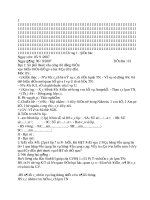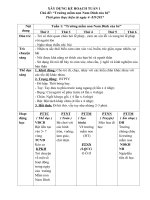9.0.1.2 Class Activity - We Need to Talk - ILM
Bạn đang xem bản rút gọn của tài liệu. Xem và tải ngay bản đầy đủ của tài liệu tại đây (72.17 KB, 2 trang )
Class Activity - We Need to Talk (Instructor Version – Optional
Class Activity)
Instructor Note: Red font color or gray highlights indicate text that appears in the instructor copy only. Optional
activities are designed to enhance understanding and/or to provide additional practice.
Objectives
Explain how transport layer protocols and services support communications across data networks.
Background / Scenario
Note: This activity works best with medium-sized groups of 6 to 8 students per group.
This chapter helps you understand how transport layer protocols and services support network data
communications.
The instructor will whisper a complex message to the first student in a group. An example of the message
might be “Our final exam will be given next Tuesday, February 5th, at 2 p.m. in Room 1151.”
That student whispers the message to the next student in the group. Each group follows this process until all
members of each group have heard the whispered message. Here are the rules you are to follow:
o
You can whisper the message only once to your neighbor.
o
The message must keep moving from one person to the other with no skipping of participants.
The instructor should ask a student to keep time of the full message activity from first participant
to last participant stating the messages. The first or last person would mostly likely be the best
one to keep this time.
o
The last student will say aloud exactly what he or she heard.
The instructor will then restate the original message so that the group can compare it to the message that was
delivered by the last student in the group.
Instructor Note: You should have a different complex message for each group of students. Initiate discussion
about what happened in the activity. Focus on these five questions:
1) Was the message complete when it reached the last student?
2) Was the message correct as delivered to the last student?
3) How long did it take for the message to get to the last student?
4) If you were depending on this message to drive your personal/business calendar, studying schedule,
etc., would the contents of this message need to be fully correct when you received them?
5) Would the length of time taken to deliver the message be important to the sender and recipient?
Instructor Note: This is an optional in-class Modeling Activity (MA). It is not intended to be a graded
assignment. Its purpose is to initiate student discussion about their perception of how data is transferred from
source to destination, both personally and in corporate practice. This MA introduces students to TCP/UDP,
transport layer content.
Required Resources
•
Timer for the student who is keeping a record of the conversation’s duration.
Reflection
1. Would the contents of this message need to be fully correct when you received them if you were depending
on this message to drive your personal/business calendar, studying schedule, etc.?
_______________________________________________________________________________________
© 2017 Cisco and/or its affiliates. All rights reserved. This document is Cisco Public.
Page 1 of 2
Class Activity - We Need to Talk
_______________________________________________________________________________________
2. Would the length of time taken to deliver the message be an important factor to the sender and recipient?
_______________________________________________________________________________________
_______________________________________________________________________________________
In the discussion initiated as a result of this activity, students should mention:
•
The importance of messages being delivered fully from sender to recipient (TCP vs. UDP - was the
message method correct to use in this situation?)
•
The importance of details within the message being correct from sender to recipient (Guaranteed vs. Nonguaranteed delivery - was the message correct as delivered to the last person?)
•
The importance of timing of a message – to the details of the message and to the date/time needed to
take action on the message (Segment establishment and delivery vs. full message delivery - did it take
very long for the message to get to the last student?)
Identify elements of the model that map to IT-related content:
•
Protocols can establish a method of sending and receiving information over a network (TCP/UDP
protocols).
•
Quality of delivery of data over a network may be affected by which protocol is used during a network
conversation (Best Effort Delivery).
•
Timing issues and factors for delivery of data over a communications system are affected by how much
data is sent at one time and by the type of transported data (Segment establishment and delivery – both
TCP and UDP).
© 2017 Cisco and/or its affiliates. All rights reserved. This document is Cisco Public.
Page 2 of 2









